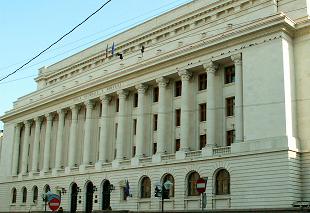NBR: domestic demand and the evolution in real terms of credit to the private sector remained in negative territory |
Autor: Bancherul.ro
2011-03-31 16:18 |
|
 In its meeting of March 31, 2011, the Board of the National Bank of Romania decided the following:
In its meeting of March 31, 2011, the Board of the National Bank of Romania decided the following:
- to keep unchanged the monetary policy rate at 6.25 percent per annum;
- to ensure adequate management of liquidity in the banking system;
to lower the minimum reserve requirements ratio on foreign currency-denominated liabilities with residual maturities of up to two years to 20 percent from 25 percent starting with the April 24-May 23, 2011, maintenance period and to leave unchanged the ratio on leu-denominated liabilities at 15 percent.
The NBR will further vigilantly monitor domestic and global economic developments so as, by using its available instruments, to ensure the fulfillment of its objectives of achieving and maintaining price stability in the medium term as well as financial stability.
The annual inflation rate rose to 7.6 percent in February 2011 from 6.99 percent in the previous month, mainly due to ample increases in food and fuel prices. This trend is in line with the balance of risks associated with the baseline scenario as outlined in the most recent medium-term inflation forecast published by the NBR (quarterly Inflation Report at http://www.bnr.ro/PublicationDocuments.aspx?icid=6876).
The analysis of macroeconomic developments reveals ongoing positive annual growth in industrial output and exports. At the same time, both real annual dynamics of other leading indicators of domestic demand and the evolution in real terms of credit to the private sector remained in negative territory.
Broad monetary conditions remained adequate for fulfilling the medium-term inflation target as the monetary policy stance stayed prudent; commercial banks’ interest rates came closer to the monetary policy rate while the leu currency witnessed a mild appreciation in nominal terms amid improvements in Romania’s balance of payments and as financial investors’ risk perception for the Romanian economy improved.
The short-term inflation outlook indicates heightened risks related mainly to factors outside the central bank’s sphere of direct influence, especially those induced - similarly to the majority of other emerging economies - by food and fuel price developments on external markets, thereby affecting domestic prices, along with persistent uncertainties related to the calendar and the magnitude of administered price adjustments. In view of the high proportion of these elements in the structure of Romania’s consumer basket, such an outlook poses concerns, NBR restating therefore the need to further firmly anchor inflationary expectations.
In this context, the NBR Board decided to leave unchanged the monetary policy rate at an annual 6.25 percent and to continue to pursue an adequate management of liquidity in the banking system. Moreover, in order to continue the gradual alignment to the European Central Bank standards in the field, the NBR Board decided to lower the minimum reserve requirements ratio on foreign currency-denominated liabilities with residual maturities of up to two years to 20 percent from 25 percent starting with the April 24-May 23, 2011 maintenance period. The minimum reserve ratio on leu-denominated liabilities was left unchanged at 15 percent.
These decisions are aimed at preserving the prospects of a sustainable resumption of disinflation and of sound economic recovery. In this context, a firm and consistent implementation of commitments agreed by the Romanian authorities under the new financing agreements with international institutions is essential to ensure a sustainable nominal and real convergence process of the Romanian economy. Furthermore, a continuous assessment of trends in non-government lending is required in order to secure adequate developments in leu-denominated loans versus foreign currency-denominated credits.
The NBR will further vigilantly monitor domestic and global economic developments so as, via an adequate use of its available instruments, to ensure the fulfilment of its objectives of achieving and maintaining price stability as well as financial stability.
According to the 12-month calendar of NBR Board meetings dedicated to monetary policy issues, the next meeting is scheduled for May 3, 2011, when a new quarterly Inflation Report will be analysed.
|
|

